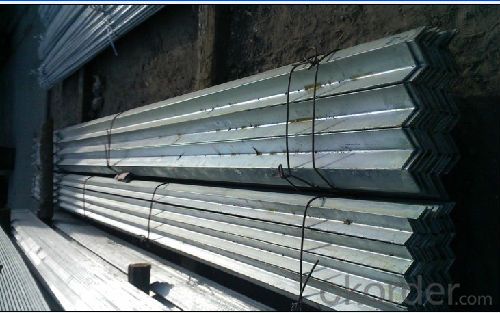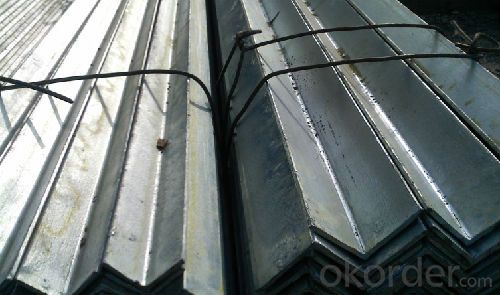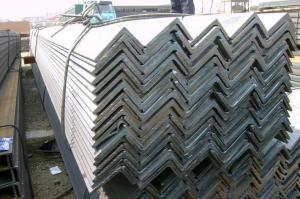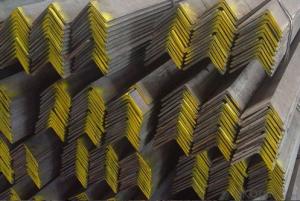Unequal Angle Steel Hot Rolled Unequal Perforated Steel Angle Iron
- Loading Port:
- Tianjin
- Payment Terms:
- TT or LC
- Min Order Qty:
- 25 m.t.
- Supply Capability:
- 30000 m.t./month
OKorder Service Pledge
OKorder Financial Service
You Might Also Like
Product Description:
OKorder is offering Unequal Angle Steel Hot Rolled Unequal Perforated Steel Angle Iron at great prices with worldwide shipping. Our supplier is a world-class manufacturer of steel, with our products utilized the world over. OKorder annually supplies products to European, North American and Asian markets. We provide quotations within 24 hours of receiving an inquiry and guarantee competitive prices.
Product Applications:
Unequal Angle Steel Hot Rolled Unequal Perforated Steel Angle Iron are ideal for structural applications and are widely used in the construction of buildings and bridges, and the manufacturing, petrochemical, and transportation industries.
Product Advantages:
OKorder's Unequal Angle Steel Hot Rolled Unequal Perforated Steel Angle Iron are durable, strong, and resist corrosion.
Main Product Features:
· Premium quality
· Prompt delivery & seaworthy packing (30 days after receiving deposit)
· Corrosion resistance
· Can be recycled and reused
· Mill test certification
· Professional Service
· Competitive pricing
Product Specifications:
Hot Rolled Equal and Unequal perforated Steel Angle Iron
1.Standard: GB,ASTM,JIS
2.Steel Grade:Q195-Q420
3.Length: 5.8-12mm
Hot Rolled Unequal perforated Steel Angle Iron
| ||
Thickness | 12mm | |
3mm-25mm | 20mm-200mm | |
Length
| 5.8-12M , according to customers' requirements | |
Standard
| GB,JIS,ASTM,EN,DIN | |
Material
| 304 304L 316 321 | |
Type | Equal and unequal | |
Usage
| constructions,communication towers and so on. | |
Certification
| ISO9001,ISO9002,API | |
FAQ:
Q1: Why buy Materials & Equipment from OKorder.com?
A1: All products offered byOKorder.com are carefully selected from China's most reliable manufacturing enterprises. Through its ISO certifications, OKorder.com adheres to the highest standards and a commitment to supply chain safety and customer satisfaction.
Q2: How do we guarantee the quality of our products?
A2: We have established an advanced quality management system which conducts strict quality tests at every step, from raw materials to the final product. At the same time, we provide extensive follow-up service assurances as required.
Q3: How soon can we receive the product after purchase?
A3: Within three days of placing an order, we will begin production. The specific shipping date is dependent upon international and government factors, but is typically 7 to 10 workdays.
Images:



- Q:Can steel angles be used for cable trays?
- Yes, steel angles can be used for cable trays. Steel angles provide structural support and stability, making them suitable for holding cable trays securely in place. They are commonly used in cable tray installations due to their strength and durability.
- Q:Can steel angles be used as supports for solar panels?
- Indeed, supports for solar panels can indeed be formed by steel angles. The strength and resilience of steel angles make them a popular choice in construction. Once adequately designed and installed, steel angles can serve as a robust and dependable support system for solar panels. By welding or bolting them together, a secure framework can be effortlessly fashioned, capable of withstanding the weight of the panels and various external factors like wind loads. Moreover, steel angles can be galvanized or coated to augment their resistance to corrosion, rendering them appropriate for outdoor applications like solar panel installations.
- Q:Can steel angles be galvanized or coated for corrosion resistance?
- Yes, steel angles can be galvanized or coated for corrosion resistance. Galvanizing is a common method used to protect steel from corrosion by applying a layer of zinc to the surface. This process creates a barrier between the steel and the external environment, preventing the formation of rust. Coating steel angles with corrosion-resistant materials such as epoxy or powder coatings is another option to enhance their resistance to corrosion. These coatings act as a protective layer, preventing moisture and other corrosive elements from reaching the steel surface. By applying galvanization or coatings, steel angles can significantly increase their lifespan and maintain their structural integrity in corrosive environments.
- Q:Can steel angles be used in electrical or telecommunications installations?
- Yes, steel angles can be used in electrical or telecommunications installations. Steel angles are commonly used in construction projects for their strength and durability. In electrical or telecommunications installations, steel angles can be used as support brackets for mounting equipment such as electrical panels, junction boxes, or communication cabinets. They provide a sturdy framework to secure and hold the equipment in place. Additionally, steel angles can be used to create cable trays and support structures for routing and organizing cables. The versatility and strength of steel angles make them a suitable choice for various applications in electrical and telecommunications installations.
- Q:I would like to ask you, angle iron, what does it usually use ah?
- The angle iron can be made up of different force components according to the different structure, and can also be used as the connecting piece between the components. Widely used in a variety of architectural and engineering structures, such as beams, bridges, towers, hoisting and conveying machinery, ships, industrial furnace, reaction tower, container frame and warehouse
- Q:Can steel angles be used in telecommunications tower constructions?
- Telecommunications tower constructions can utilize steel angles. These angles are frequently employed as structural elements in diverse construction projects, such as telecommunications towers. Their utilization imparts the tower with robustness, stability, and assistance. By welding or bolting steel angles together, a solid and long-lasting framework is formed, capable of enduring the tower's weight and equipment. Moreover, steel angles can be conveniently customized and fabricated to satisfy the precise design and engineering prerequisites of the telecommunications tower.
- Q:What are the common welding techniques used for steel angles?
- The common welding techniques used for steel angles include MIG (Metal Inert Gas) welding, TIG (Tungsten Inert Gas) welding, and stick welding (Shielded Metal Arc Welding - SMAW). MIG welding, also known as GMAW (Gas Metal Arc Welding), is a widely used technique that involves feeding a continuous wire electrode into the weld pool while an inert gas, such as argon or a mixture of argon and carbon dioxide, is used to shield the weld zone from atmospheric contamination. MIG welding is known for its ease of use, high welding speeds, and ability to handle thicker materials. TIG welding, also known as GTAW (Gas Tungsten Arc Welding), is a more precise welding technique that uses a non-consumable tungsten electrode to create the arc and a separate filler material if necessary. TIG welding provides excellent control over the weld pool and produces high-quality welds with minimal spatter. It is commonly used for thinner materials and applications that require a higher level of precision. Stick welding, also known as SMAW (Shielded Metal Arc Welding), is a versatile and widely used welding process. It involves striking an arc between a flux-coated electrode and the workpiece, creating a weld pool that is protected by the flux coating. Stick welding is known for its portability and ability to handle various materials and thicknesses. It is commonly used in construction, maintenance, and repair work. These welding techniques can be used for steel angles, which are often found in structural applications, such as frames, braces, and supports. The selection of the welding technique depends on factors such as the thickness of the steel angle, the required weld quality, and the specific application. It is important to consider the welding process, proper joint preparation, and welding parameters to ensure a strong and durable weld joint.
- Q:Can steel angles be used for pedestrian bridges or walkways?
- Yes, steel angles can be used for pedestrian bridges or walkways. Steel angles provide strength, stability, and durability, making them suitable for supporting the weight of pedestrians and ensuring the safety of the structure.
- Q:What are the different types of steel angles used in fencing and gates?
- The different types of steel angles commonly used in fencing and gates include equal angles, unequal angles, and rolled steel angles. Equal angles have equal sides and are often used for vertical posts in fencing and gate frames. Unequal angles have different side lengths and are commonly used for horizontal rails and bracing in fencing and gates. Rolled steel angles are manufactured by rolling steel into a specific shape and are often used for structural support and reinforcement in fencing and gate systems.
- Q:Are steel angles recyclable?
- Yes, steel angles are recyclable. Steel is one of the most commonly recycled materials in the world because it retains its properties even after being melted and reshaped multiple times. This means that steel angles can be recycled and used to create new steel products. Recycling steel angles helps conserve natural resources, reduce energy consumption, and minimize the amount of waste that ends up in landfills. Additionally, the recycling process for steel is highly efficient and cost-effective, making it a sustainable option for the construction industry and other sectors that use steel angles.
1. Manufacturer Overview |
|
|---|---|
| Location | |
| Year Established | |
| Annual Output Value | |
| Main Markets | |
| Company Certifications | |
2. Manufacturer Certificates |
|
|---|---|
| a) Certification Name | |
| Range | |
| Reference | |
| Validity Period | |
3. Manufacturer Capability |
|
|---|---|
| a)Trade Capacity | |
| Nearest Port | |
| Export Percentage | |
| No.of Employees in Trade Department | |
| Language Spoken: | |
| b)Factory Information | |
| Factory Size: | |
| No. of Production Lines | |
| Contract Manufacturing | |
| Product Price Range | |
Send your message to us
Unequal Angle Steel Hot Rolled Unequal Perforated Steel Angle Iron
- Loading Port:
- Tianjin
- Payment Terms:
- TT or LC
- Min Order Qty:
- 25 m.t.
- Supply Capability:
- 30000 m.t./month
OKorder Service Pledge
OKorder Financial Service
Similar products
New products
Hot products
Related keywords



























